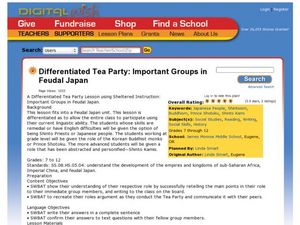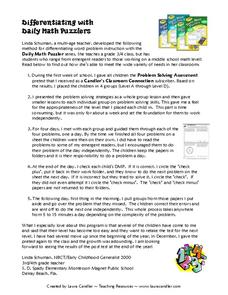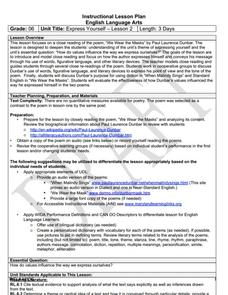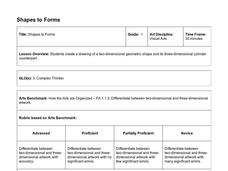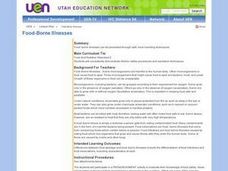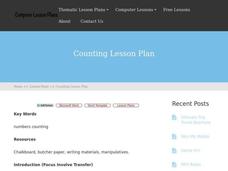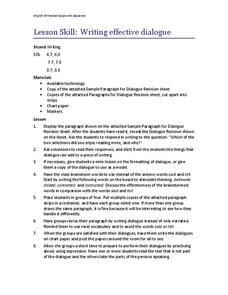Health Smart Virginia
Mental and Emotional Health
Working in groups, sixth-graders identify internal factors that negatively impact them. Then, explain how they could change that factor into a positive influence. Finally, individuals create personal mind maps that identify their...
Curated OER
REPRODUCTION
Students complete a variety of activities to study different concepts in Science. The activities are part of a layered curriculum. This is used to differentiate instruction and give a wide variety of assessment opportunities.
Curated OER
Differentiated Tea Party: Important Groups in Feudal Japan
Students research the different groups in Feudal Japan. In this Japanese people lesson, students are broken into different groups representing the different roles in Japan. They research their group and have a "tea party" in which they...
Curated OER
Differentiating with Daily Math Puzzlers
Students practice word problems based on their own needs and skill levels. In this math word problems lesson, students practice completing one word problem each day until they can move on to the next level.
Curated OER
6th Grade: Express Yourself, Lesson 2: Close Read
The second lesson of a pair about Paul Laurence Dunbar, this plan focuses in particular on his poem, "We Wear the Masks." After a short historical introduction, class members conduct a series or readings, marking up the text and...
Curated OER
Matchstick Math: Using Manipulatives to Model Linear, Quadratic, and Exponential Functions
Playing with matches (unlit, of course) becomes an engaging learning experience in this fun instructional unit. Teach pupils how to apply properties of exponential functions to solve problems. They differentiate between quadratic and...
Curated OER
Introduce Vocabulary: Kindergarten Count to 100
During read-aloud of Kindergarten Count to 100 by Jacqueline Rogers, children listen for context clues about vocabulary that includes the words "first," "second," and "third." I love the way vocabulary development skills are integrated...
Curated OER
Cell Structures
Students differentiate between a prokaryotic and eukaryotic cell and give examples of both types. They differentiate between a plant and animal cell. Students will be able to name features common to both as well as unique features of each.
Curated OER
Using a Venn Diagram to Compare / Contrast: Double Bubble
Create a "Double Bubble" to organize information in a Venn diagram-like graphic organizer. There are a few options included to differentiate this assignment, but unfortunately, there are no topics for selection. Provide your...
Curated OER
Main Idea/Supporting Details Scavenger Hunt
Engage your class in a scavenger hunt to find the main ideas and supporting details in a text. They follow the teacher while s/he models how to determine main idea and find supporting details, and then they work independently. A fun...
Curated OER
Shapes to Forms
Here is a math lesson that is really a visual arts lesson in disguise! In it, pupils utilize their knowledge of geometric shapes and forms to create a detailed version of a cylinder. The instructions on how to go about the task are very...
Curated OER
Parts of Speech: Building Good Sentences
Using technology, 3rd graders will complete a reinforcement project to differentiate between nouns (common and proper), verbs, adjectives, adverbs, and pronouns. Using the teacher-made template, they will create PowerPoint slides on the...
Curated OER
Can you Follow Me? Conventions
Use the present tense to create written assignments. Critical thinkers take a passage written in past or future tense and rewrite it in present tense. They then write a set of instructions in present tense.
Curated OER
A Simple Task Made Complex: Types of Sentences
Looking for a lesson about differing sentence types? Use this lesson on compound and complex sentences in your grammar unit. After composing simple, compound, complex and compound-complex sentences individually and as part of a group,...
Curated OER
Area & Perimeter Assessment And Practice
Using a pre-test, this lesson starts by establishing differentiated learning groups. Each group practices determining area and perimeter using interactive web sites small groups are then pulled aside and given additional support as...
Curated OER
Hula How?
Third graders start writing papers with much more regularity than they did in the previous grades. They are starting to differentiate between the styles of writing and know why each is important. This activity gives the them a chance to...
Curated OER
Atomic Structure in the Chemistry Classroom
Students are introduced to many of the scientists who contributed to the creation of the model of the atom. The changes to and evolution of the model over time is also covered. At the end of the lesson, Students differentiate between...
Curated OER
Farms And Cities
Students differentiate the differences of living on a farm or in a city. They do this with the use of coloring pictures and have group discussion about each picture to identify characteristics and identify where the picture is from. The...
Curated OER
Number Sense and Numeration
Students add and subtract integers. In this algebra lesson plan, students discuss number sense as they sort numbers in the correct order. They analyze and label numbers differentiating between rational and irrational numbers.
Curated OER
Food-Borne Illnesses
Use this lesson to have your charges consider the differences between food spoilage and food-borne illnesses including the differentiation of food infections and food intoxication, including characteristics of each. Some excellent...
Curated OER
Counting Lesson Plan
In whole group practice, children count together and identify how many objects are drawn on butcher paper, increasing the number when they have achieved fluency. In pairs, they count manipulatives. They then copy series of numbers from...
Virginia Department of Education
Media Literacy and Persuasive Writing
Investigate ways to persuade by introducing learners to the three rhetorical appeals (Pathos, Logos, Ethos). Pupils receive a worksheet for their definition development of the terms and coinciding vocabulary words. The activity continues...
Curated OER
Applying Phonetic Principles
Young readers develop their phonetic skills by using a nifty tool called a word pocket. They use the tool to help them organize individual letters that they have at their desks to spell entire words and to construct beginning and ending...
Virginia Department of Education
Writing Effective Dialogue
Spend a productive hour in the classroom with this tutorial where junior high writers discover how to create snappy dialogue. The learning begins with an analysis of sample writing and discussion on the effectiveness of each piece. The...


